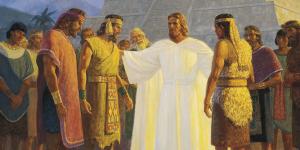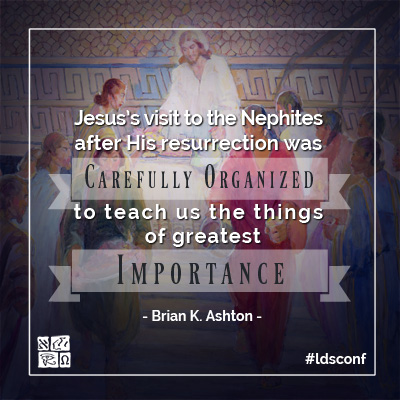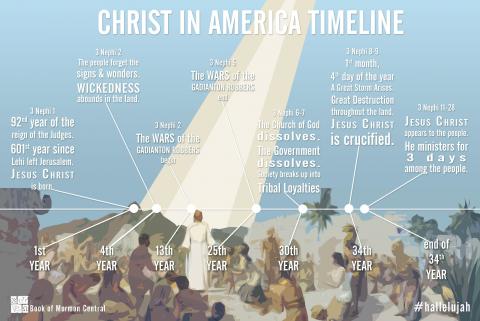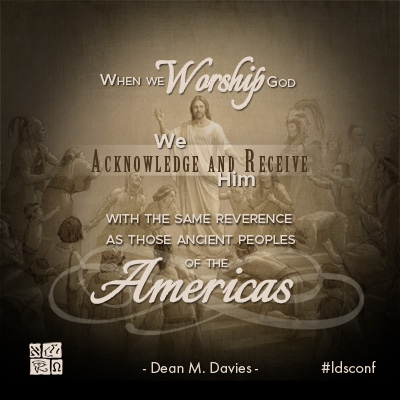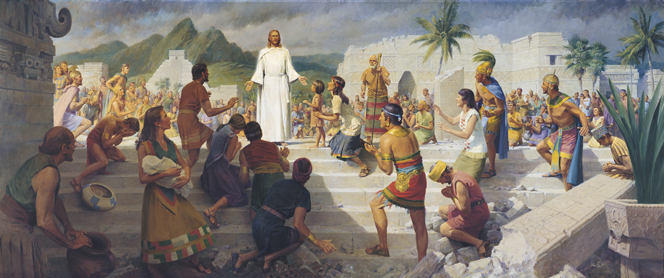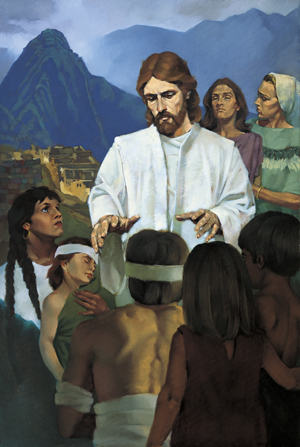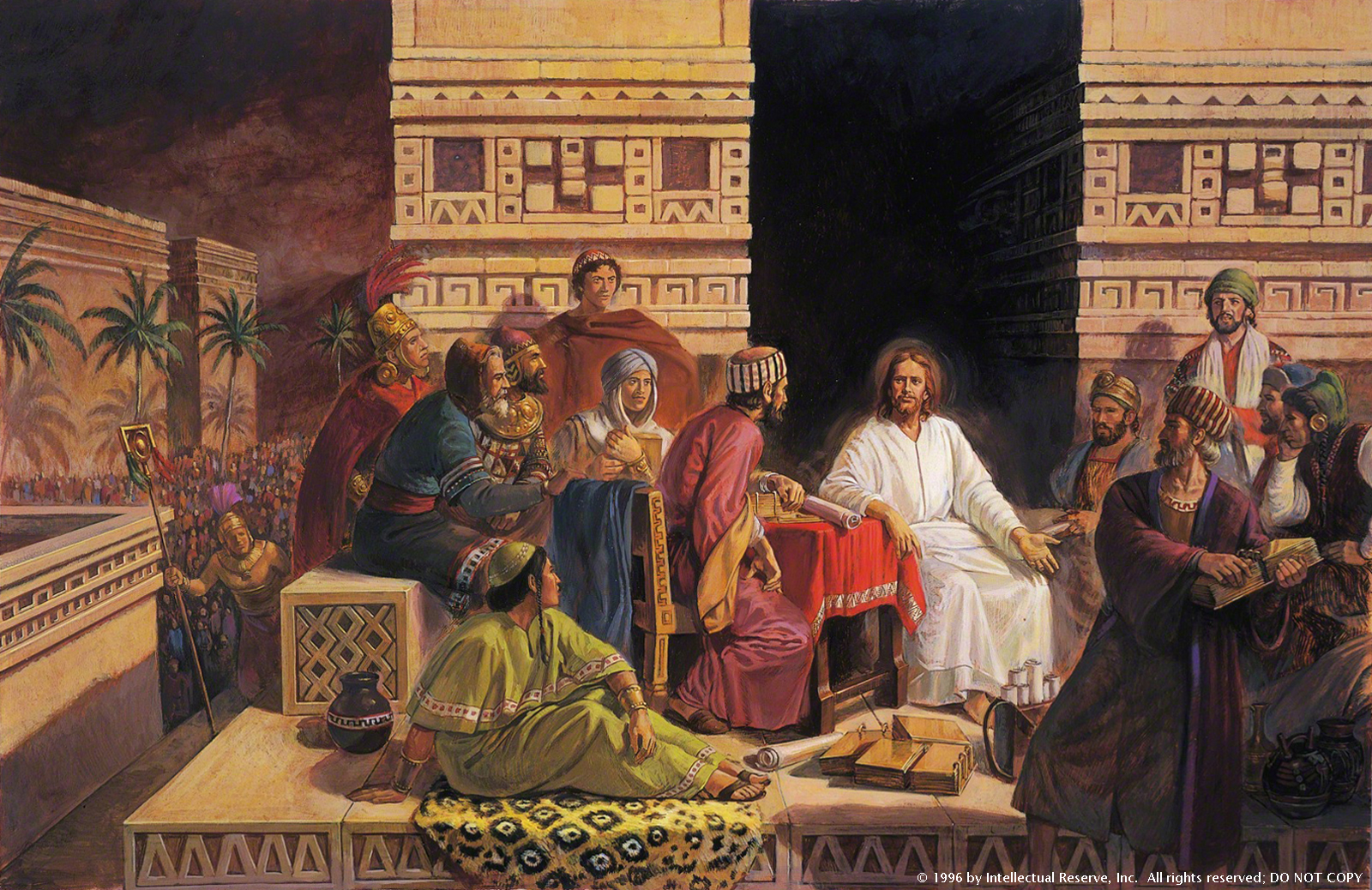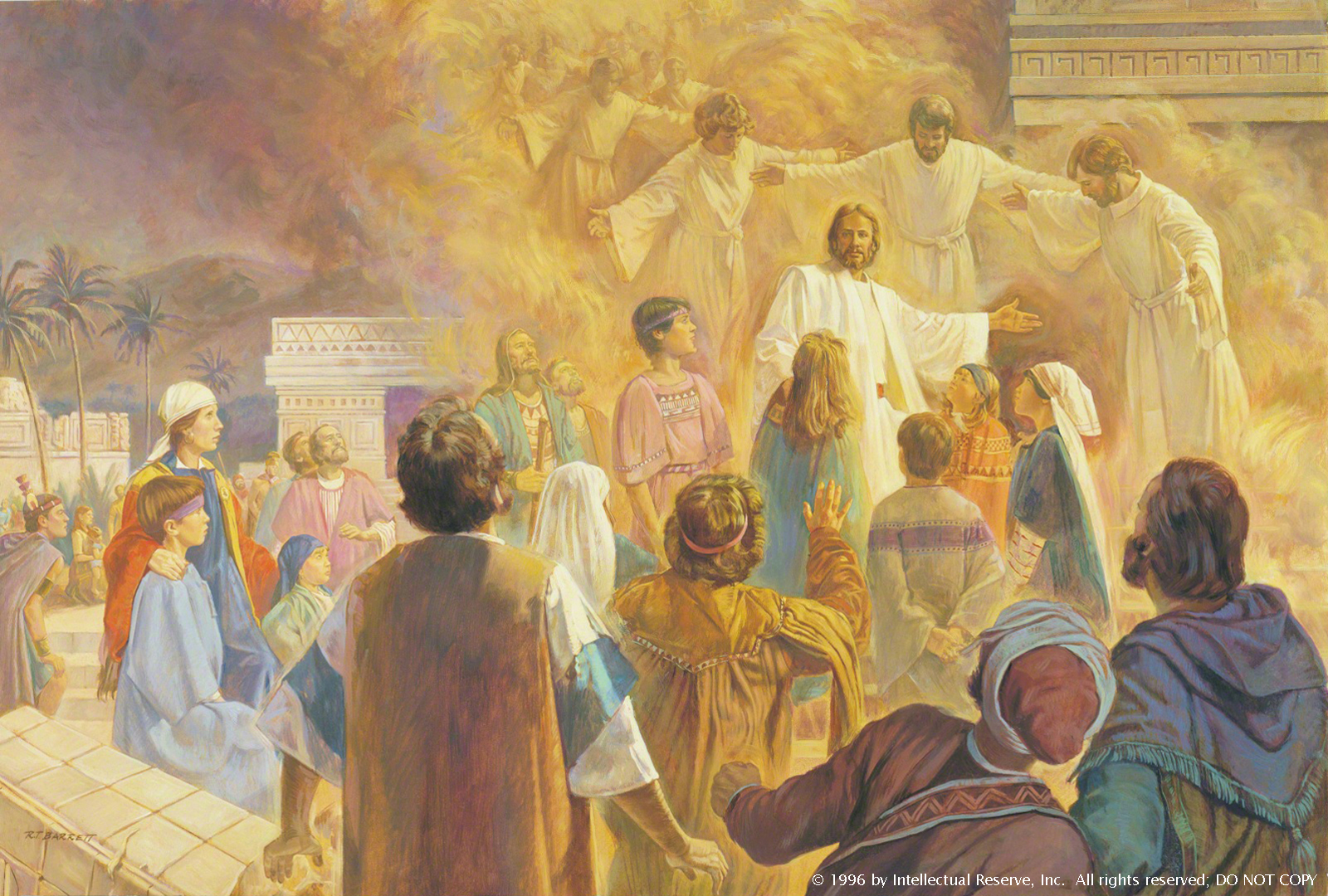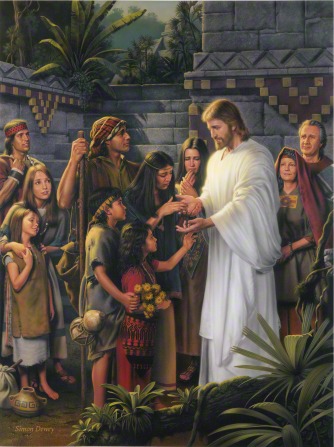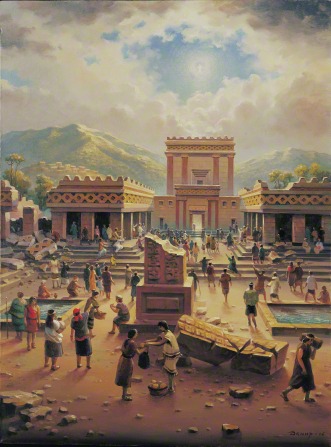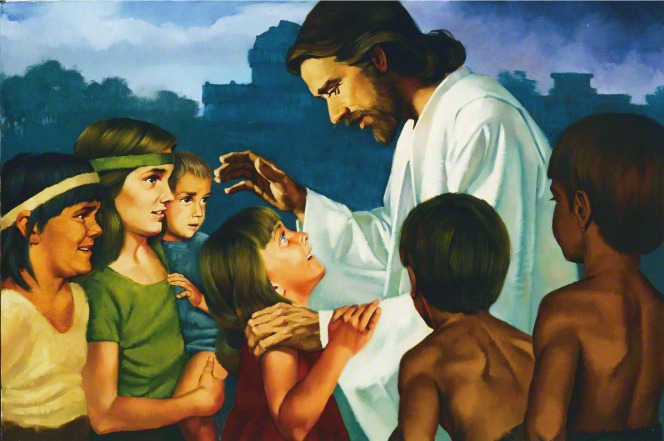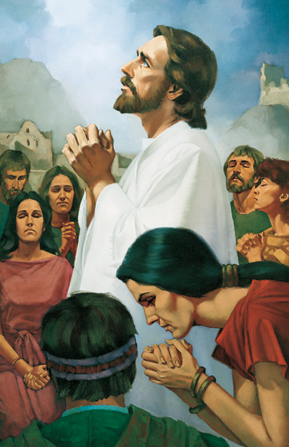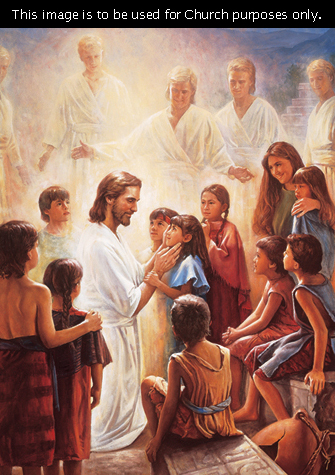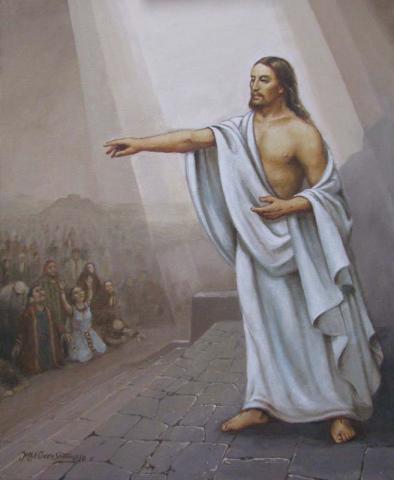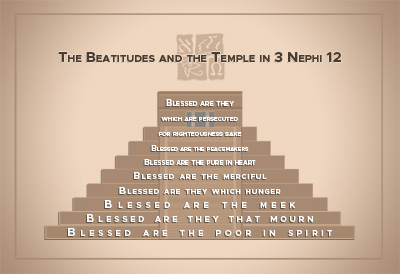You are here
Book of Mormon Central is in the process of migrating to our new Scripture Central website.
We ask for your patience during this transition. Over the coming weeks, all pages of bookofmormoncentral.org will be redirected to their corresponding page on scripturecentral.org, resulting in minimal disruption.

Scripture Block
3 Nephi 27 - 4 Nephi 1
To help class members understand the fundamental doctrines of the gospel of Jesus Christ and to teach them that living the gospel is the only way to true and eternal happiness.
Lesson Manual
KnoWhys
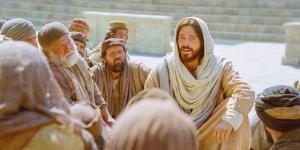
Why Must We Do What Jesus Did?
3 Nephi 27:22
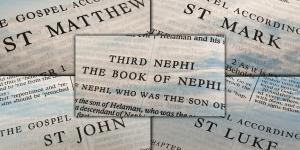
Why Is 3 Nephi Sometimes Called the “Fifth Gospel”?
3 Nephi 27:21
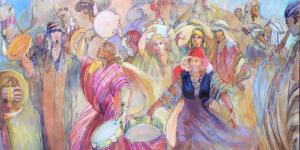
Why Did the Peace Last So Long in 4 Nephi?
4 Nephi 1:16
Articles
Overview
Benson, Ezra Taft. "The Savior's Visit to America." General Conference Address April 1987.
A conference address from President Ezra Taft Benson on Christ's ministry among the Nephites in 3 Nephi.
Bokovoy, David E., and John A. Tvedtnes. "Christ in the Old Testament and the Book of Mormon." In Testaments: Links between the Book of Mormon and the Hebrew Bible, 7-23. Toelle, UT: Heritage Press, 2003.
All of the key events, doctrines, and people of the Hebrew Bible point directly to Jesus’ role as the Anointed One of Israel. This is the inspired message proclaimed so passionately by the ancient authors of the Book of Mormon: Jesus is the link between the Book of Mormon and the Hebrew Bible.
Holland, Jeffrey R.. Atonement of Jesus Christ In Encyclopedia of Mormonism, Edited by Daniel H. Ludlow. Vol. 1. New York: Macmillan, 1992.
An encyclopedic entry on the Atonement of Jesus Christ, as explained by Elder Jeffrey R. Holland. The Atonement is the core tenet of Christianity, and is the central focus of the Book of Mormon.
Ludlow, Victor L.. "Covenant Teachings in the Book of Mormon." In The Fulness of the Gospel: Foundational Teachings from the Book of Mormon, edited by Camille Fronk Olson, Brian M. Hauglid, Patty Smith and Thomas A. Wayment, 225-245. Provo, UT: Religious Studies Center, 2003.
This article discusses all the cases where Christ made covenants with his people in the Book of Mormon. Of note is the instance in 3 Nephi, when Christ visites the Nephites in the Americas and puts away the Law of Moses for a new covenant.
Matthews, Robert J.. "Jesus the Savior in 3 Nephi." In The Book of Mormon: 3 Nephi 9-30, This is My Gospel, edited by Monte S. Nyman and Charles D. Tate, Jr., 25-39. Provo, UT: Religious Studies Center, 1993.
This article discusses Jesus Christ's role in 3 Nephi. Third Nephi offers greater insight into the activity and scope of Jesus' work than that found in the New Testament alone. Matthew discusses the anticipation of Christ's coming, his miraculous appearance in the Americas, the doctrines he taught, and how Jesus Christ's coming is significant for the message of the Book of Mormon and the Gospel of Jesus Christ.
Millet, Robert L., Gary Lee Walker, Jerry C. Giles, Gerald Hansen, Jr., Andrew C. Skinner, Philip J. Schaelling, Daniel C. Peterson, Merril C. Oaks, Tad R. Callister, John Gee et al. Jesus Christ In Encyclopedia of Mormonism, Edited by Daniel H. Ludlow. Vol. 2. New York: Macmillan, 1992.
Encyclopedic entry on Jesus Christ, as he is understood in Mormon theology. Jesus Christ plays a central role in the Book of Mormon, especially when he appears to the Nephites in 3 Nephi.
Nelson, Russell M.. "Jesus the Christ - Our Master and More." In A Book of Mormon Treasury: Gospel Insights from General Authorities and Religious Educators, 19-31. Provo, UT: Religious Studies Center, 2003.
In a thoughtful overview, Elder Russell M. Nelson discusses how Jesus Christ fulfills each of Biblical and Book of Mormon titles attributed to him.
Seely, David R.. Jehovah, Jesus Christ In Encyclopedia of Mormonism, Edited by Daniel H. Ludlow. Vol. 2. New York: Macmillan, 1992.
An Encycopedic entry emphasizing the messianic role of Jesus Christ in Mormonism. Jesus Christ is the Jehovah and God of the Old Testament and was prophesied to come down to earth to redeem his people.
Tanner, N. Eldon. "Christ in America," Ensign. May 1975.
A Conference address from the First Counselor in the First Presidency on Christ in America. Starting with Biblical prophecies of Christ, President Tanner tells the story of Christ's appearance, expounding on the doctrines Christ layed out to the Nephites.
Turner, Rodney. "Christ's Church in America." Ensign. March 2000.
The Church of Jesus Christ experienced three phases in Book of Mormon times: the Old Testament-era Church among the early Nephites, the revitalization of the Church in Alma’s time, and the Church organized by the risen Lord.
Welch. John W. "Seeing Third Nephi as the Holy of Holies of the Book of Mormon." Journal of the Book of Mormon and Restoration Scripture 19, no. 1 (2010): 36-55.
Third Nephi and its account of the ministry of the resurrected Jesus to the Nephites has long been seen as the pinnacle of the Book of Mormon. This text can also be viewed as the Holy of Holies of the Book of Mormon. Everything in 3 Nephi, especially the ministry of the Savior, echoes themes related to the temple and the presence of the Lord in the Holy of Holies. Themes such as silence, timelessness, unity, awe, and consecration confirm this interpretation.
Hyde, Paul Nolan. A Comprehensive Commentary of the Book of 3 Nephi. Orem, UT: Parrish Press, 2015.
Kimball, Linda Hoffman. "The Coming of Christ." In The Reader's Book of Mormon: The Coming of Christ: Helaman 5 – 3 Nephi, edited by Robert A. Rees and Eugene England, vii-xxix. Salt Lake City: Signature Books, 2008.
3 Nephi 27
Lund, Gerald N. "I Have a Question." Ensign August 1986.
The Savior said that we should be perfect, even as he and our Father in Heaven are perfect. Gerald Lund answers the question on how we are supposed to achieve this seemingly impossible goal, and how we can avoid discouragement.
Reynolds, Noel B.. "The Gospel as Taught by Nephite Prophets." In Reexploring the Book of Mormon, edited by John W. Welch, 257-259. Provo, UT: FARMS, 1992.
The Book of mormon uses the words "gospel" and "doctrine" to refer to the way by which individuals come unto Christ. Reynolds identifies 6 tenets of the "gospel" as defined in the Book of Mormon, and explains how this definition of "gospel" and "doctrine" are consistent throughout the whole work.
Reynolds, Noel B.. "The Gospel of Jesus Christ as Taught by the Nephite Prophets." BYU Studies Quarterly 31, no. 3 (1991): 31-50.
This article details the tenets of the Gospel of Jesus Christ as found in the Book of Mormon. The article draws much from what Christ layed out for the Nephites in 3 Nephi.
Skinner, Andrew C. "'This Is My Gospel': Jesus' Discourse in 3 Nephi." Religious Educator 11, no. 3 (2010): 123-143.
The statements of Jesus Christ in 3 Nephi 27:13-21 regarding "the gospel" are unique in scripture. Nowhere else in sacred writ does Jesus personally define the term with such power, clarity, and simplicity. Nowhere else does he declare personal ownership or authorship of the gospel he preached and explain it as the carrying out o his Father's will. And nowhere else in scripture does he connect so directly and succinctly his Father's will with the Crucifixion, Resurrection, and Final Judgment, and link them to the universal salvation offered to humankind.
Welch, John W. "Reusages of the Words of Christ." Journal of Book of Mormon Studies 22, no. 1 (2013): 62-72.
This is an excerpt from and summary of an article by John W. Welch that appeared as “Echoes from the Sermon on the Mount,” in The Sermon on the Mount in Latter-day Scripture.
Welch, John W. “Echoes from the Sermon on the Mount,” in The Sermon on the Mount in Latter-day Scripture, ed. Gaye Strathearn, Thomas A. Wayment, and Daniel L. Belnap (Provo, UT: Religious Studies Center, Brigham Young University; Salt Lake City: Deseret Book, 2010), 312–40.
Jesus quoted key phrases, often in inverted order, from the Sermon on the Mount (3 Nephi 12–14) in subsequent Book of Mormon chapters (3 Nephi 15–28), thus demonstrating that the sermon was accepted as an authoritative text establishing and defining Jesus’s kingdom on earth. Although rarely considered in this light, Peter, James, Paul, and the gospel writers quoted from all parts of the Sermon on the Mount, similarly substantiating the authoritative functions of the sermon as a foundational text in early Christianity. Literary analysis supports the ideas that these quotations were intentional, that an awareness of the sermon was widespread in the earliest decades of Christianity, and that audiences to which Jesus and his apostles spoke were familiar with the teachings and commandments found in the Sermon on the Mount.
3 Nephi 28
Williams, Clyde J. "The Three Nephites and the Doctrine of Translation." In The Book of Mormon: 3 Nephi 9-30, This is My Gospel, edited by Monte S. Nyman and Charles D. Tate, Jr., 237-251. Provo, UT: Religious Studies Center, 1993.
While translation is ambiguously referred to in the stories of Elijah and John the Beloved, the Latter-day Saint is unique in its development of the doctrine of translation. This article walks through the history of translation in Church History, and how the story of the Three Nephites is integral to our understanding of translated beings.
Wilson, William A. "Three Nephites" In Encyclopedia of Mormonism, Edited by Daniel H. Ludlow. Vol. 4. New York: Macmillan, 1992.
An encyclopedia entry on what is known of the Three Nephites as first found in the book of 3 Nephi.
Anonymous. "Out of the Dust: Names of the Three Nephites?" Journal of Book of Mormon Studies 9, no. 1 (2000): 68-69, 80.
Oliver Huntington was an early LDS pioneer who wrote or dictated numerous reminiscences, including on his association with Joseph Smith. On 16 February 1895, he wrote the names of the three Nephites who “do not sleep.” Historians find that some of what he recorded does not square with other reports. Without corroborating statements from other sources, we cannot know if he is correct.
Judd,Frank F. Jr. and Terry L. Szink. "John the Beloved in Latter-day Scripture." In The Doctrine and Covenants, Revelations in Context: The 37th Annual Brigham Young University Sidney B. Sperry
What is the significance of the parallels between 3 Nephi 28 and section 7? It is likely that the Savior simply used the same phraseology when speaking to the Nephite disciples and also the Apostles Peter and John. But it is also possible that these similarities may suggest more.
4 Nephi 1
Van Dyke, Blair G.. "Light or Dark, Freedom or Bondage: Enhancing Book of Mormon Themes through Contrasts." Religious Educator: Perspectives on the Restored Gospel 6, no. 3 (2005): 99-116.
While this article deals with strong contrasts throughout the Book of Mormon, Van Dyke highlights an example found in 4 Nephi. 4 Nephi both establishes a great era of prosperity and peace, and then very quickly dissolves into another period of war and wickedness. He discusses how this contrast can be meaningful for the everyday reader.
Skinner, Andrew C. "Zion Gained and Lost: Fourth Nephi as the Quintessential Model." In The Book of Mormon: Fourth Nephi Through Moroni, From Zion to Destruction, edited by Monte S. Nyman and Charles D. Tate, Jr., 289-302. Provo, UT: Religious Studies Center, 1995.
Of all the descriptions of Zion found in holy writ, none is as singularly instructive as the one presented in 4 Nephi. It not only teaches us about the social and religious characteristics of Zion in a more detailed way than other descriptions, but also illuminates in unmistakable terms the root causes of the demise of a Zion society.
Sperry, Sydney B. "What the Book of Mormon Is (Concluded)." Journal of Book of Mormon Studies 4, no. 1 (1995): 28-40.
An analysis of the text of 3 Nephi to Moroni. Third Nephi was written by Nephi, the son of Nephi, the son of Helaman. Fourth Nephi in turn was written by the son of Nephi3 also called Nephi, and Nephi4‘s son Amos and grandsons Amos and his brother Ammaron. The book of Mormon was principally inscribed by Mormon and Moroni. The book of Ether exposes the terrible end of a people persisting in wickedness. The book of Moroni shows his love for his enemies.

